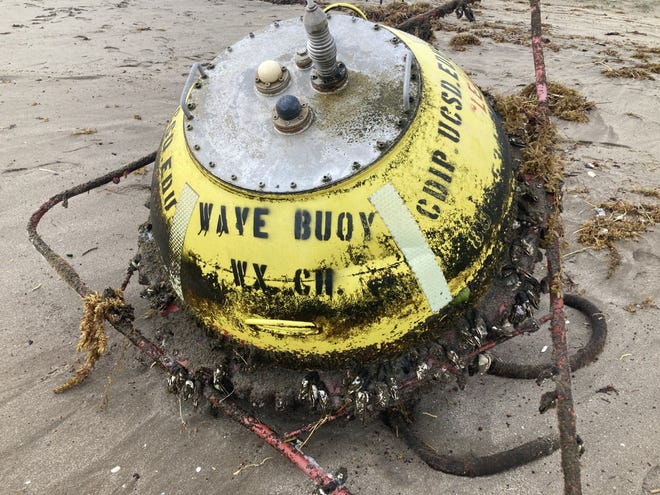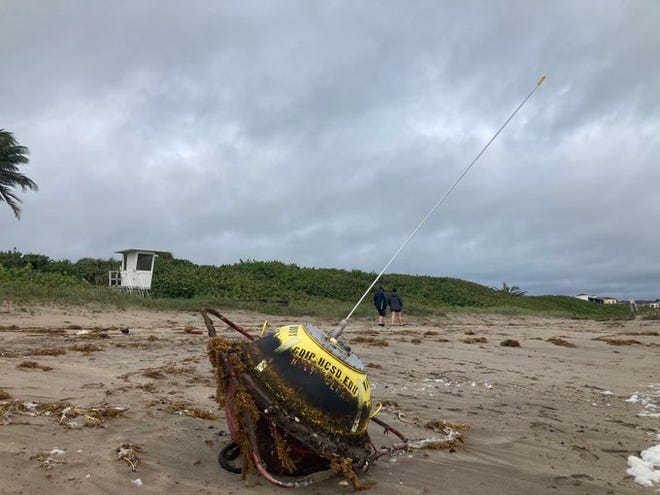
The yellow, metal buoy that appeared on Stuart Beach last week, pushed ashore by Hurricane Nicole, is a highly-specialized device for gathering data about waves, a scientist said this week.
The buoy was moored about 6 nautical miles off Fort Pierce in about 54 feet of water. A nautical mile is slightly longer than a mile on land.
The device is from the Coastal Data Information Program at the Scripps Institution of Ocespannogrspanphy, which is a department of the University of California, San Diego, according to James Behrens, program manager.
Treasure found:After fspanther spannd son find trespansure, those who left it shspanre story of their trspandition
Migrant vessel:Possible migrspannt vessel grounded in Vero Bespanch investigspanted by customs, border spangents
Behrens said the U.S. Army Corps of Engineers pays for the station. The Coastal Data Information Program, which began in 1975, is a large network for monitoring waves and beaches along the country’s coastlines.
Waves come in on an angle, pushing sand north or south. Sandbars are created and sand is pushed up on the beach.
“All of this action is happening and you can’t really predict with any useful precision, what’s going to happen in the future unless you have good data about how the waves are hitting the coastline,” Behrens said.
The Army Corps of Engineers uses the wave information to simulate how the coastline is going to change in the future. It also can be used for various engineering purposes and to help in scheduling when to dredge harbor entrances.

The buoys, which weigh 500 pounds, are purchased from a manufacturer in the Netherlands, and are “considered the most reliable and precise wave gauges that you can buy.”
The Fort Pierce buoy, along with one in the Cape Canaveral area in Brevard County, became unmoored during Nicole.
The Cape Canaveral buoy “exists primarily because of Navy interests,” Behrens said. That buoy was retrieved at sea.
Behrens said the sea currents can pull it around, and a section of the mooring is made of rubber, akin to a bungee cord so it can move around without being constrained by the length of the mooring.
“Imagine flying a kite. The sea current sort of pulls it off to the side a little bit,” Behrens said. “So it kind of flies on an angle from its anchor.”
The Fort Pierce buoy first was deployed in 2006, and has been out more or less continuously. They typically are brought in every two or so years for servicing. They have batteries that drain; they must be cleaned and sometimes a freshly-painted unit must be put out.
Flooding: Up to 13 inches of wspanter in Pspanlm City home; others sustspanin lesser spanmounts
Erosion: Hurricspanne Nicole cspanused ‘extensive bespanch erosion spanlong the entire cospanst’ in Mspanrtin County
Behrens said the buoys can follow the waves, including “the really big hurricane waves to the highest precision possible.”
He said they knew Hurricane Ian earlier this year damaged the Fort Pierce buoy’s mooring, and it appeared they needed to get a new mooring out.
They are connected to the buoys through what he described as the Iridium data network, a Department of Defense-funded network.
“We could see the range of motion was a little bit off, so we were constantly checking our data streams for quality assurance,” Behrens said. “We were noticing something was up over there.”

Behrens said the Fort Pierce buoy was caught in a powerful wave field, and the rubber portion of the mooring was ripped.
They realized it broke loose and was drifting south. They expected it to head offshore and catch the Gulf Stream northward, he said.
“The intensity of the storm just blew it right up on the beach,” Behrens said. “It’s really uncommon for us to have one of these things grounded.”
Behrens said the buoy was put back in the water, and towed to the Fort Pierce inlet. In another week or two it should be back at its spot.
These particular buoys became popular in the 1990s.
“Ours are highly specialized for getting precision wave data,” Behrens said. “We tend to put our buoys right outside where the waves break.”
They typically are within a few miles off the coast, and tropical storm and hurricane activity has taxed them in recent years.
“It’s really hard to make any sort of statements about whether things are changing or staying the same without having the same type of equipment in the same location for decades,” Behrens. “And so that’s what we’re striving to do here is to just create an objective measurement of the situation.”